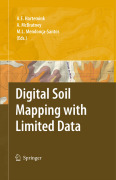
Digital soil mapping with limited data
Hartemink, A.E.
McBratney, A.
Mendonça-Santos, M. de L.
There has been considerable expansion in the use of digital soil mapping technologies and development of methodologies that improve digital soil mapping atall scales and levels of resolution. These developments have occurred in all parts of the world in the past few years and also in countries where it was previously absent. There is almost always a shortage of data in soil research and its applications and this may lead to unsupported statements, poor statistics, misrepresentations and ultimately bad resource management. In digital soil mapping, maximum use is made of sparse data and this book contains useful examples of how this can be done. Digital soil mapping (DSM) is an emerging and expanding topic in soil science There is a growing interest from neighbouring disciplines The book presents the latest technologies, challenges and ideas related to DSM 35 chapters range from overviews of the DSM technology in general to specific applications in areas without much soil information or areas where specific parameters are investigated INDICE: From the contents I. Introduction.- II. Dealing with limited spatial data infrastructures.- III. Digital Soil Mapping - Methodologies.- IV. Digital Soil Mapping - Examples.- V. Priorities in Digital Soil Mapping.
- ISBN: 978-1-4020-8591-8
- Editorial: Springer
- Encuadernacion: Cartoné
- Páginas: 440
- Fecha Publicación: 01/08/2008
- Nº Volúmenes: 1
- Idioma: Inglés
